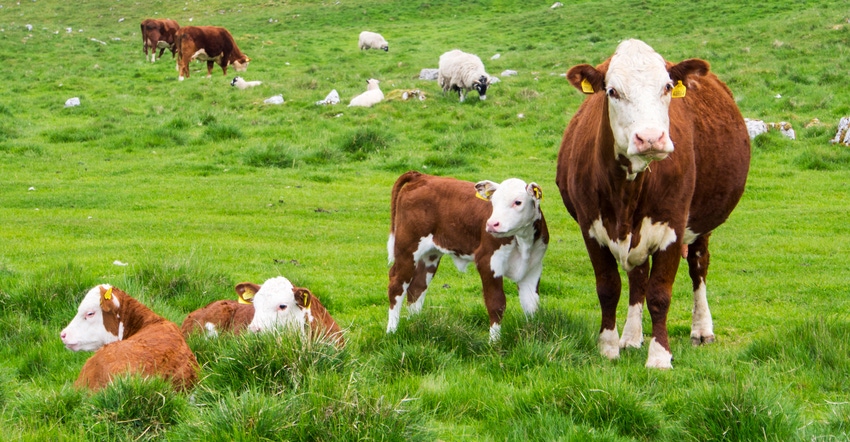February 25, 2022

Editor’s note: This is the second article in a series of two. The first piece, “Factors contributing to weak calf syndrome,” appeared online at OhioFarmer.com on Feb. 17.
If pregnant cows in your herd have been losing weight, especially in late gestation, it is best to prepare for the birth of weak calves. Several measures should be instituted immediately to save as many calves as possible:
Monitor closely. Check heifers and cows in labor frequently (at least 2-3 times daily). Although producers are accustomed to watching heifers closely for calving difficulty, this recommendation should be extended to all cows. Once the water bag or hooves appear, the calf should be born within an hour.
If the cow is not making progress, call your veterinarian for help. If signs of labor are observed for six or seven hours and the water bag does not appear, the calf may be breech (tail first). Again, call for help quickly for a better chance to have a live calf.
Provide shelter. Provide shelter during harsh winter weather. Unrolling hay on the ground where there are windbreaks or wooded areas provides some protection during times of intense rain and cold. A shed or barn can be beneficial, but remember organisms that cause calf diarrhea build up very quickly in those protected areas.
Barns should be clean, dry and well-bedded if used for calving. If cows were not vaccinated with scours vaccine before calving, there are products available to give the calf by mouth at birth to aid in scours prevention.
Institute special care. Identify the weak calves, and institute special care. If the calf is slow to stand and nurse, intervention is necessary. It is important to dry the calf off, dip or spray the navel with disinfectant, warm the calf and feed colostrum with an esophageal feeder. Have a good-quality commercial colostrum replacement (not supplement) on hand and ready to mix and feed.
Do not delay because the longer the interval from birth to feeding, the fewer antibodies absorbed by the calf. If you observe a calf frequently attempting to nurse, it is unlikely to be getting enough milk and may need supplementation.
Evaluate nutrition needs. Test your hay, then evaluate the protein and energy in the ration and address any deficiencies. Determine the body condition score of the cows and heifers due to calve in the next 60 days to evaluate their needs. In addition, remember lactating cows have the greatest need for energy because they are producing milk.
If possible, separate cows according to their nutritional needs and feed them accordingly. Creep-feeding calves will help the older calves continue to grow and lessen the burden on the lactating dams.
Lessen mud. Do your best to feed in different spots to avoid creating areas of deep mud. Calves and weak cows will get stuck in deep mud and die. Similar to the La Brea tar pits, mud is very sticky and will trap weaker animals until they die of exhaustion or fall prey to a predator. Fields can be fixed when winter is over.
Determine causes of death. Diagnose the cause of unexpected death in newborn calves. Contact your local veterinarian, and submit any calves that die due to unknown causes to the University of Kentucky Veterinary Diagnostic Lab or Breathitt Laboratory in Hopkinsville, Ky.
Keys to prevention
The best strategies to prevent weak calves next calving season are a solid vaccination and deworming program, proper nutritional management and avoiding dystocias. Not only will calf survival improve, but pregnancy rates also will increase as well.
Vaccinate cows at least four to six weeks before breeding with a 5-way viral respiratory vaccine (IBR, BVD Types 1 & 2, PI3, BRSV), with vibriosis and the five strains of leptospirosis. Consult your veterinarian about testing the herd for persistent infection with BVD virus.
Test your hay and plan to provide enough protein and energy for cows and heifers with a balanced ration based on the stage of production (lactation, mid- or late gestation). Ensure a clean, uninterrupted water supply, 24 hours a day, seven days a week.
Maintain a body condition score of 5 for cows (up to a 6 for heifers) to ensure adequate condition at calving.
Allow cows access to some form of shelter in case of bad weather when calving. However, if unable to keep this area clean, calves are far better off being born outside in a grassy area.
Have enough help on hand at calving to watch cows, assist with calving and treat weak calves, if necessary. A strong relationship with your local veterinarian is exceptionally important for difficult calving situations and the evaluation and treatment of weak calves.
Arnold is with the UK Veterinary Diagnostic Laboratory.
Source: OSUE, which is solely responsible for the information provided and is wholly owned by the source. Informa Business Media and all its subsidiaries are not responsible for any of the content contained in this information asset.
You May Also Like




